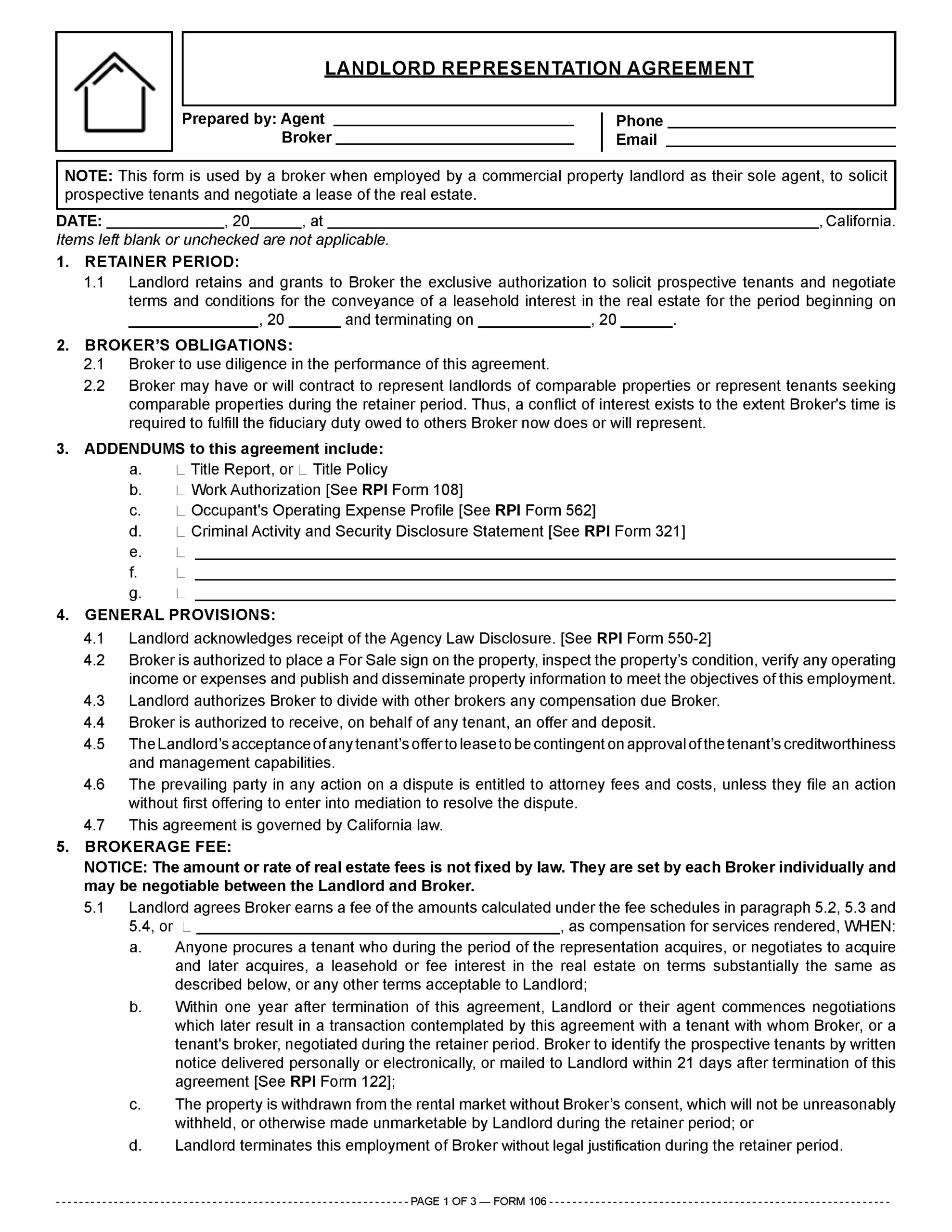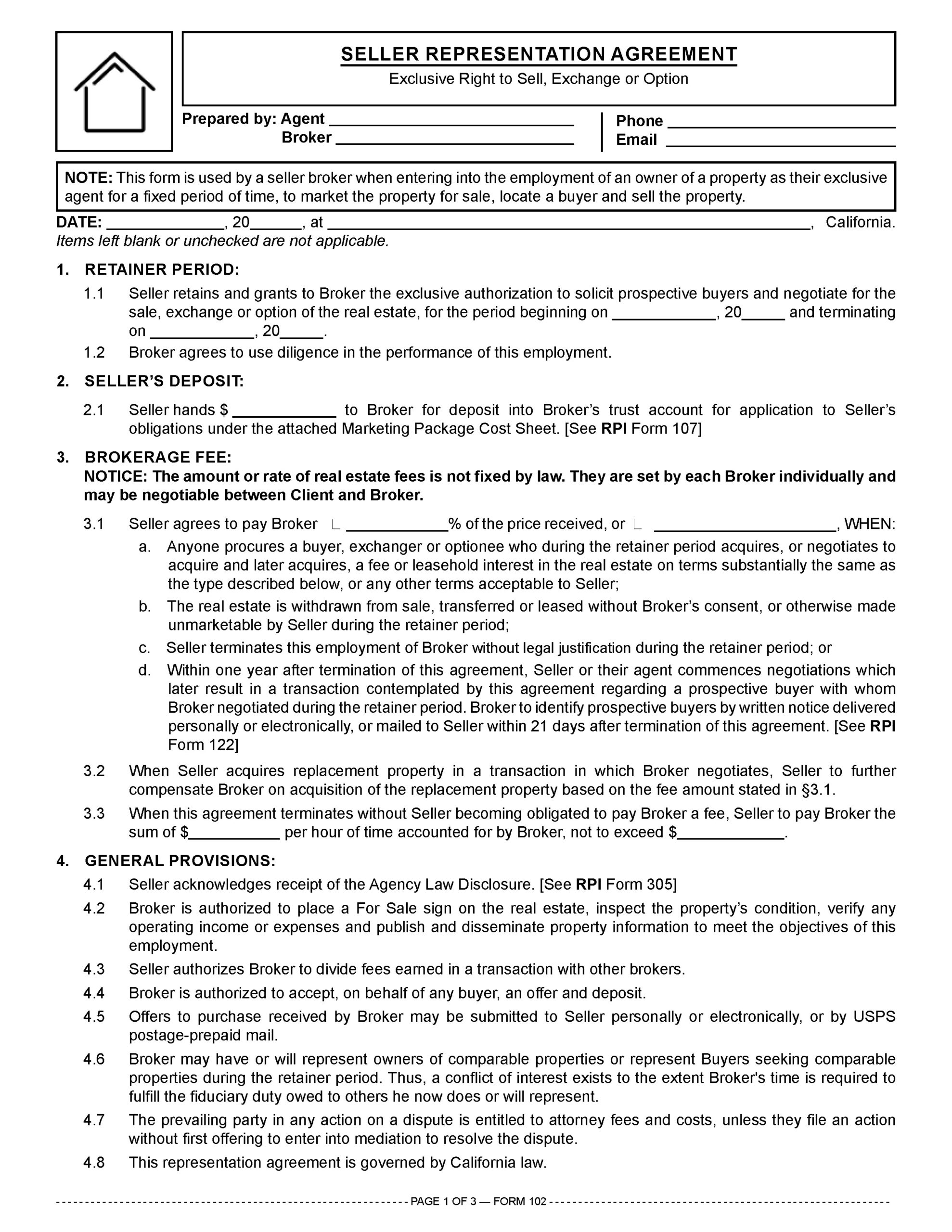Why this matters: A broker employed by a landlord to market the property to tenants, screen tenants and negotiate lease terms in exchange for a fee uses a Landlord Representation Agreement — the leasing equivalent of a Seller Representation Agreement.
When to use a landlord representation agreement
Consider a landlord who owns a multi-unit apartment building in California. The landlord doesn’t have time and feels inadequately situated to locate tenants for vacant units, screen tenants and negotiate rental or lease agreement terms.
The landlord decides to hire a real estate broker specializing in property leasing. The broker is licensed to:
- market the property for rent or lease;
- locate prospective tenants; and
- negotiate agreements for occupancy by tenants. [Calif. Business and Professions Code §10131(b)]
To formalize the broker’s employment, the landlord and broker enter into a Landlord Representation Agreement. [See RPI Form 106]
The Landlord Representation Agreement authorizes the broker to market the property as available for lease, show it to prospective tenants, obtain offers to lease and negotiate the terms of a lease agreement on the landlord’s behalf, in exchange for a fee. [See RPI Form 106]
A landlord representation agreement is different from a Property Management Agreement. A property management agreement authorizes the broker to act as the non-resident property manager to:
- locate tenants, enter into occupancy agreements and collect rents;
- prepare all notices required of management to be delivered to tenants;
- oversee maintenance and tenant behavior; and
- account and report to the landlord for their operation of the property. [See RPI Form 590]
In contrast, a landlord representation agreement provides for the broker or agent to locate a tenant and lease the property, not manage the tenants and property.
Related video:
Read more about broker duties in exchange for a fee.
Using the landlord representation agreement
A landlord representation agreement is the leasing equivalent of a seller representation agreement for selling ownership of a property. [See RPI Form 102]
The landlord representation agreement is entered into:
- when the landlord employs a broker to act as their exclusive representative to locate tenants or negotiate rental or lease agreements in expectation of a fee;
- before the broker or agent markets or advertises the property as available for lease; and
- before showing the property to prospective tenants and negotiating lease terms.
For example, when a property owner asks a broker to “find me a tenant” (residential or commercial), the broker first has the owner sign a landlord representation agreement to employ the broker. [See RPI Form 106]
The employment of a leasing agent by an owner is handled in much the same manner a broker negotiates with an owner to enter into a seller representation agreement to locate a buyer and sell the property. The signed writing is required for the broker to enforce collection of an earned fee from a client. [Bus & P C §10176(f)]
Further, the representation agreement contains wording for the implicit duty of the broker to use diligence in pursuing the client’s objective as well as noting the fiduciary duties of loyalty, fair dealing and confidentiality owed to any client. It also prevents disputes about when the broker earns a fee and the amount of the fee earned. [See RPI Form 102 and 106]
The broker earns a fee
Under the landlord representation agreement, a broker earns a fee when a tenant, during the representation period, enters into a rental or lease agreement to take possession on the terms stated in the representation agreement, or any other terms the landlord agrees to.
The landlord representation agreement also includes a safety clause which ensures the broker still earns a fee when the broker introduces the landlord to a prospective tenant who later leases the property after the retainer period expires (for up to one year).
Related video:
Read more about the safety clause.
The amount of the broker fee agreed on in the representation agreement may be:
- a flat dollar amount [See RPI Form 106 §5.1];
- a percentage of the total rent for the initial lease term (for example, 8% of the total rent due for the first year or 5% of the total rent for the first five years) [See RPI Form 106 §5.2]; or
- an hourly rate when the agreement terminates without otherwise earning a fee. [See RPI Form 106 §5.6]
Further, the broker earns a fee when a tenant acquires fee ownership of the property. This expectation of a fee on transfer of the fee simple ownership interest to a tenant mandates a written agreement between the owner and the leasing agent when the broker undertook the initial step to represent the owner. [See RPI Form 106 §5.4]
Analyzing the landlord representation agreement
A broker uses the Landlord Representation Agreement published by Realty Publications, Inc. (RPI) when they are employed by a commercial property landlord as their sole agent. It allows the broker to solicit prospective tenants and negotiate a lease of the real estate. [See RPI Form 106]
The Landlord Representation Agreement contains:
- Retainer period: The commencement and termination date of the broker’s exclusive representation of the landlord. [See RPI Form 106 §1]
- Broker’s obligations: Broker agrees to use diligence in the employment as well as disclose conflicts of interest involving their representing other clients with similar needs as the landlord-client. [See RPI Form 106 §2]
- Addendums: Including:
- title report;
- title policy;
- work authorization [See RPI Form 108];
- occupant’s operating expense profile [See RPI Form 562];
- criminal activity and security disclosure statement [See RPI Form 321]; and
- blank spaces for additional addenda. [See RPI Form 106 §3]
- General provisions: the Agency Law Disclosure is provided to the landlord as mandated, the broker is authorized to place a “For Sale” sign on the property and perform as expected to meet the objectives of the employment, the landlord authorizes the broker to divide any fee earned with other brokers, the broker is authorized to receive an offer and deposit on behalf of any tenant, a tenant’s offer to lease is contingent on the tenant’s creditworthiness, and a mediation provision and choice-of-law provision are included. [See RPI Form 106 §4]
- Brokerage fee: The broker and landlord agree the broker earns a fee when:
- anyone procures a tenant who acquires a leasehold or fee interest in the real estate on terms substantially the same as described in the agreement;
- a tenant the broker has negotiations with and named in a written notice sent to the landlord and later enters into a transaction with the landlord within one year after the landlord representation agreement terminates;
- the property is withdrawn from the rental market without the broker’s consent; or
- the landlord terminates the employment without legal justification during the retainer period. [See RPI Form 106 §5.1]
- Brokerage fee: The percentage of total rent the broker receives each year or other year for leaseholds and fee ownership acquisitions and an hourly fee the broker is to receive when the agreement terminates without the landlord becoming obligated to pay the broker a fee. [See RPI Form 106 §§5.2 through 5.6]
- Real estate: The type, address and vesting of the property controlled by the agreement, along with any encumbrances of record, including first and second mortgages and other liens. [See RPI Form 106 §6]
- Personal property: A blank to list personal property included with the real estate. [See RPI Form 106 §7]
- Condition of title: Whether the landlord’s interest in the property is fee simple, leasehold or other, and landlord warrants there are no unsatisfied judgments pending against them, no condemnation/eminent domain proceedings against the property, and no unrecorded deeds or encumbrances against the property. [See RPI Form 106 §8]
- Lease terms: How long the lease term is expected to be, when occupancy is available, the initial rent, the day of the month rent is due, the formula the landlord will apply to determine rent changes after the initial term, the total deposit, including advance rent amounts and security deposit, the late charge amount, and when it incurs, plus interest, which utilities and insurance the tenant is responsible for, what the landlord is responsible to maintain, the lease form the landlord intends to use, and other terms. [See RPI Form 106 §9]
- Signatures: The landlord, broker and agent sign and date the form and provide their contact information. [See RPI Form 106]
Related article:
Exclusive seller representation agreements
An exclusive seller representation agreement affords a real estate broker the greatest protection of their fee. It is also the most commonly used type of employment.
The exclusive seller representation agreement employs the broker as the sole agent to act on the behalf of the owner to market the property and negotiate any sale with all potential buyers and their agents. The broker is entitled to a fee regardless of who procures the buyer. [See RPI Form 102]
Under the exclusive seller representation agreement, the owner relinquishes their right to market the property with other brokers or defeat entitlement of the seller broker to compensation by selling the property themselves or removing it from the market.
An owner of real estate, on entering into an exclusive seller representation agreement, grants a broker the right to locate a buyer for the property prior to the expiration of the period of employment specified in the seller representation agreement.
The broker is entitled to the fee agreed to in the representation agreement when, during the retainer period:
- the property is sold on any terms, no matter who produces the buyer; or
- the broker or their agent presents the seller with a bona-fide offer from a ready, willing and able buyer on terms sought by the seller under the representation, or on other terms accepted by the seller. [Calif. Civil Code §1086(f)(1)]
Exclusive seller representation agreements give a broker and their agents the greatest incentive to work toward attaining the client’s goal of locating a buyer. The seller broker does not compete with the client to sell the property — they work together to achieve the sale. [See RPI Form 102]
Related video:
Read more about exclusive seller representation agreements.
Analyzing the seller representation agreement
A seller broker uses the Seller Representation Agreement — Exclusive Right to Sell, Exchange or Option form published by RPI when entering into the employment by a property owner as their exclusive agent for a fixed period of time. The form allows the seller broker to market the property for sale, locate a buyer and sell the property without interference. [See RPI Form 102]
Each section in the exclusive seller representation agreement has a separate purpose and need for enforcement. The sections include:
- Brokerage services: The employment period for rendering brokerage services, the broker’s due diligence obligations and any advance deposits by the seller. [See RPI Form 102 §§1 and 2]
- Broker fee: The seller’s obligation to pay a broker fee, the amount of the fee and when the fee is due. [See RPI Form 102 §3]
- Conditions:Authority for the broker to receive a buyer’s purchase offer, accept a good-faith deposit, enter into fee-splitting arrangements with brokers representing buyers and enforce the representation agreement. [See RPI Form 102 §4]
- Property description and disclosures: Identification of the listed real estate and any personal property that is also being sold, the terms of existing financing and attached addenda. [See RPI Form 102 §§5, 6 and 7]
- Sales terms: The price and terms sought by the seller for the sale, exchange or option of the property. [See RPI Form 102 §§8, 9, 10 and 11]
- Signatures and identification of the parties:On completion of entries on the representation agreement and any attached addenda, the seller and broker or their agent sign the document consenting to the employment. [See RPI Form 102]
Similarly, when a short sale of a property is involved, the broker uses a version of the representation agreement with a short sale contingency. [See RPI Form 102-1]
Related video:
Read more about the seller representation agreement.
















